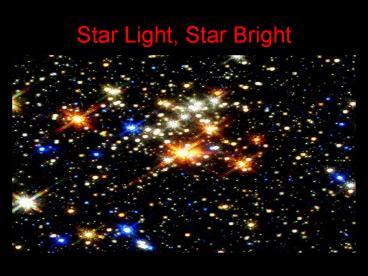Star Light, Star Bright - PowerPoint PPT Presentation
1 / 31
Title:
Star Light, Star Bright
Description:
Parallax- the apparent change in position of a star due to the movement of observer Life Cycle of a Star Life ... Star Life Cycle of Stars 1 2 Cool and ... – PowerPoint PPT presentation
Number of Views:235
Avg rating:3.0/5.0
Title: Star Light, Star Bright
1
Star Light, Star Bright
2
3 Factors that determine the brightness of a star
- Temperature
- Hotter the star the brighter
the star - Blue..white..yellow.orange..red
- HOTTEST----------------------------------------
------COOLEST
3
Size
- Larger the star Brighter the Star
- Smaller the star Dimmer the Star
4
Distance
- Closer the star Brighter the star
- Further the star Dimmer the star
5
Brightness Key Terms
- Luminosity
- Apparent Magnitude
- Absolute Magnitude
- Parallax
6
Luminosity
- Definition- actual or true brightness of a star
- Total amount of energy given off
- Dependent on 2 things
Temperature
Size
6000K
6000K
6000K
10,000K
More luminous
More luminous
7
Apparent Magnitude
- Definition- how bright a star appears when seen
from earth - System developed where a number is assigned to a
star based on brightness - Smaller Brighter the star
- Bigger Dimmer the star
- Sun -28 , Full Moon -11, Polaris 7
- Hubble can see 28
8
Absolute Magnitude
- Definition- brightness of a star as if all stars
were seen from the same distance
Earth
Earth
Sun- average star, Abs. Mag of 4.8 (less
luminous, looks brighter because closer) Rigel-
orion, Abs, Mag. of -6.4 (more luminous, further
away)
To Determine apparent magnitude and distance to
earth
9
Moving Stars?
- Parallax- the apparent change in position of a
star due to the movement of observer
Finger left/right
10
Life Cycle of a Star
11
Life Cycle of Stars
Planetary Nebula
White Dwarf
Red giant
1
Main Sequence Star
Nebula
Protostar
Red supergiant
Supernova
Black Hole
2
Neutron Star
12
Life Cycle Introduction
- http//www.youtube.com/watch?vf_KLOFe2rDY
- http//www.youtube.com/watch?vYU6X3SPZAJo
13
Step 1 Initiation
- Stars are born in nebulae (huge clouds of gas and
dust) - Nebula begin to condense when an outside force,
such as shock wave, acts upon it
14
Step 2 Pre-star
- A protostar forms when a part of the nebula
contracts, shrinks, and pressure and internal
temperature increases - Protostar begins to glow where nebula is
contracting
15
Step 2 contd A star is born
- As contraction, temperature, density, and
pressure increase protostar gets larger and
brighter - Center becomes so hot fusion begins
- Once fusion begins, a star is born
- TRUE STAR
16
Step 3 Teenager star
- Internal temperature hot enough to start fusion
at center said to be a main sequence star - Sun is an example
- Each protostar will turn into one main sequence
star - 90 of stars are main sequence stars
- Vary in surface temperature and absolute magnitude
17
Fate determined by Size
- If a normal size star (Sun) follows path 1
- If star is a GIANT follows path 2
18
- Path 1
19
Step 4 Middle-aged star
- Red giant- very bright, once an average star, but
is now close to end of life - Has expanded to many times its original size
(heat causes it to expand) - Hydrogen core has turned to helium and eventually
to carbon - Our sun will become a red giant star in about 5
billion years
20
Star like our sun begins to die
- Star begins to die when its core temperature
rises to a point where fuel is used up - A carbon-oxygen core forms
- Eventually the gases at a stars surface begin to
blow away in abrupt bursts - Resulting glowing halo is called a planetary
nebula
21
Death of a star like our sun
- atoms no longer fuse, fuel is used up
- Outer gases escape leaving the core which
collapses and shrinks - Heat still present but will continue to escape
for about a billion of years
- White Dwarf- small, very dense, hot star at the
end of its life, mostly carbon with nuclear cores
depleted (about the size of earth but heavier)
22
- Path 2
23
Step 4 Middle-aged massive star
- Supergiant- largest known type of star
- can be as large as our solar system
- rare but exists
- In a massive star, hydrogen is fused more quickly
and fusion continues until a iron nuclei is
formed
24
Death of a Supergiant
- Supernova- exploding star
- Elements are used up very quickly and eventually
runs out of fuel - Collapse of the core produces a shock wave that
blasts the stars outer layers into space
producing a supernova
25
Option A after a supernova
- When neutron star is first formed, it spins very
rapidly and gives off radio waves
- After a massive star goes supernova it leaves
behind its core (called a neutron star) - -Neutron Star- small, dense star made of neutrons
26
Option B after a supernova
- Black Hole- a star that collapses
- How do we know they exist? Pulls gases off nearby
stars, as gas is pulled into this nothing space
x-rays are emitted from the gas as molecules are
pulled in
27
Cycle continues
- Star is born from great clouds of gas and dust
- Stars mature, grow old, and die
- As a star dies, it makes new clouds of dust gas
and dust where new stars can begin to form - More massive a star, the shorter its life
28
- http//www.youtube.com/watch?vHfqcZdNnQ6s
29
Hertzsprung-Russell Diagram
- Graph that compares temperature and absolute
magnitude (brightness)
30
The Hertzsprung-Russell Diagram (H-R diagram)
Cool and bright
Bright
Hot and bright
Cool and dim
Hot and dim
Sun
Dim
Cool
Hot
31
Supergiants
Cool and bright
Hot and bright
Giants
Main sequence
Cool and dim
White Dwarfs
Hot and dim































